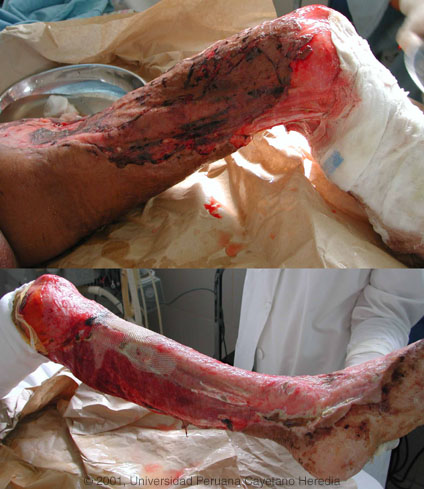2001 Case #4 |
 |
|
2001 Case #4
|
 |
|
| Diagnosis: Severe local necrosis by venom of Bothrops atrox |
| Discussion: Severe local necrosis and hemorrhage is more characteristic with vipers and pit vipers than with elapid snakes (cobras, mambas, coral snakes, kraits and others). Species of Bothrops account for most of the serious snakebite in Latin America and range from Mexico to Argentina. Bothrops can adapt to habitats varying from grasslands to rainforest. These are medium to long snakes (0.7 to Although details from the referring hospital are incomplete, this patient did receive appropriate polyvalent antivenin according to standard Peruvian protocols. This includes a test dose followed, as in this case, by 6 vials of antivenin given by slow IV push. Despite this and adequate hydration the severe necrosis rapidly ensued. Fortunately the bleeding stopped at that time. Unfortunately, soon after the skin grafts were placed and despite good wound care, the patient developed a gram negative sepsis with hypotension and requiring intubation. This is a frequent complication in patients with this degree of necrosis. After 4 days in ICU the sepsis was treated successfully and patient was discharged back to the ward. Fatalities due to Bothrops envenomation are common among indigenous peoples in the Amazon basin. The snakes are not aggressive and will only attack if disturbed. Travelers should be educated to be alert when walking in the rainforest. The use of first aid measures such as compression and immobilization in viperidae envenomation is highly controversial and the aim should be to transport to hospital care quickly. Expedition travelers to remote locations can consider carrying a supply of antivenin but its use does not obviate the need for rapid transport to a medical facility for management of IV fluid administration and support of cardiorespiratory compromise that may ensue.
|
